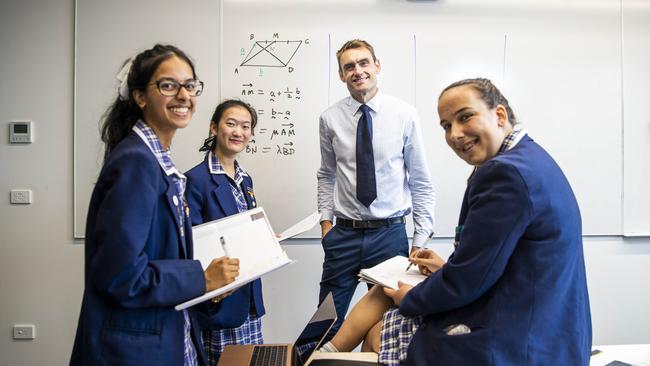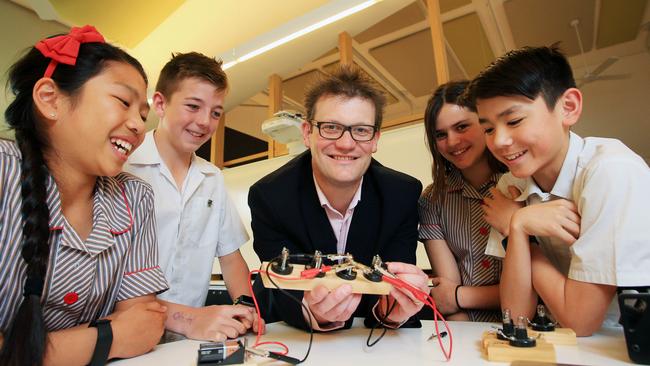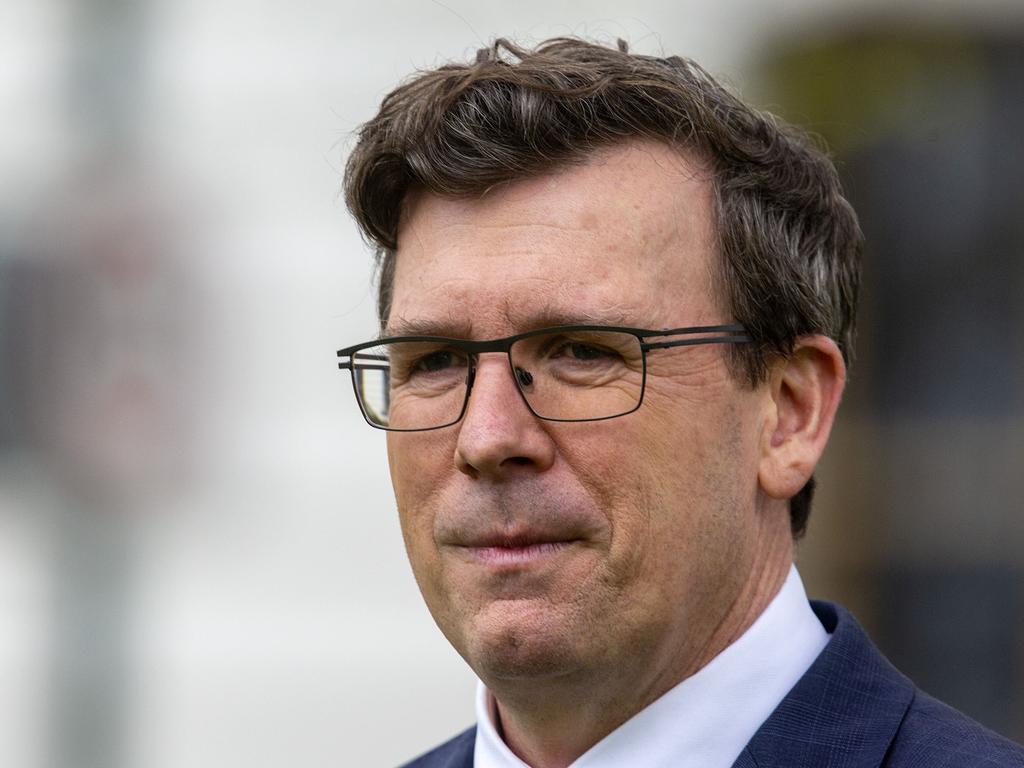Maths wars: the great divide
Should students be explicitly taught, or should they be given more freedom to discover things for themselves? It’s the big maths wars question that’s divided teachers.

When mathematics teacher Anthony Harradine takes cake to class he knows he’s going to have his students’ full attention.
This particular day’s lesson is short division. The year 6 students at Adelaide’s Prince Alfred College have already mastered the important skill – however, over the next half-hour they will be guided through an activity designed to deepen their understanding.
Harradine calls for four boys to be the recipients of nine slices of cake. They each receive two and most already know that the remaining slice should be quartered and shared evenly.
“Bear with me,” Harradine says patiently. He proceeds to carve the piece into 10 smaller, equal parts. Yet the problem persists: they still will not share equally. So he continues to chop the remaining two slivers of cake into even smaller parts – much to some students’ horror. “Crumbs!” they shriek.
By the end of the lesson, however, the students are tossing around their own explanations of why the division algorithm works and understand that even a portion of humble Madeira cake can be ascribed a decimal value.
They are clearly engaged and enjoying the tactile nature of what some might call an inquiry-style learning activity.
But is it the best way to teach mathematics?
“It depends,” says Harradine. It’s a phrase the teacher of 37 years uses frequently when discussing his views on the so-called maths wars – which, similar to the more famous reading wars, are based on whether children should be explicitly taught versus whether they should be given more freedom to discover things for themselves.
Prior to the 1980s, students were typically taught maths explicitly, with a strong emphasis on memorisation and practice to the point that knowledge and skills became automatic – think times tables. However, the theory of constructivism has led to a boom to more progressive student-centred methods, including inquiry-style learning. As the theory goes, learning is more valuable when it is driven by the student themselves, rather than enforced.
Although originally a US phenomenon, the maths wars have flared up locally following the release of a draft new national school curriculum in April.
Co-designed by the firm of US educational futurist Charles Fadel, an outspoken advocate of the 21st century skills-over-knowledge movement, the revised maths curriculum has elevated the role of problem-solving in the teaching of maths, with the aim of supporting “deeper conceptual understanding to make mathematical learning more meaningful, applicable and transferable to students’’.
Reworded content descriptions – which specify the essential knowledge, understanding and skills that students are expected to learn – are littered throughout, with references to students having to “solve problems”, “explore”, “investigate” or “model” during lessons; all terms synonymous with inquiry-style learning.
The draft curriculum also introduces the term “mathematising”, which means to “treat or regard a situation or problem mathematically”. It is here that it becomes clear the teaching of maths in Australia is no longer about teaching for maths’ sake but rather so young people can apply their maths learning to “authentic” or “real world” problems.
Australian Curriculum, Assessment and Reporting Authority chief executive David de Carvalho sought to explain the rationale behind the proposed direction at an education summit last month, saying that while a maths student might be able to memorise Pythagoras’s theorem, they may not necessarily know why the formula works every time.
“The process of discovering that for themselves, with the assistance of the teacher, is what makes learning exciting,” de Carvalho said. “And when we understand a topic, it is easier to recall the facts because they are no longer just random bits of information but are organised into intelligible ideas.”
It’s an argument that Victorian maths teacher and author Greg Ashman disagrees with, pointing to a significant body of evidence that says such inquiry or discovery learning is less effective than teacher-led teaching.
“The draft (curriculum) is not so much pushing problem-solving as it is pushing for problem-based learning – learning through solving problems,” Ashman says.
“I don’t believe that a curriculum document should mandate any style of mathematics teaching, and it is especially concerning that the draft curriculum is mandating learning through inquiry and problem-solving.”
Ashman differs from mainstream opinion on this. Leading up to the release of the draft curriculum, and following a leak of some draft documents, the Australian Association of Mathematics Teachers, the Australian Mathematical Sciences Institute, the Australian Academy of Science, and the Mathematics Education Research Group of Australasia issued a public statement calling for problem-solving to be central to how maths is taught. According to the group, teaching maths content was no longer sufficient.
According to the groups, the change was necessary to arrest Australia’s declining performance in maths on international tests such as the OECD’s Program for International Student Assessment, which is conducted every three years. The nation’s decline has been such that the average 15-year-old who sat the 2018 test is more than one full year of schooling behind in maths compared to 2003. Equally concerning is the Trends in International Mathematics and Science Study, which found that 30 per cent of Australian year 4 students and 32 per cent of year 8 students failed to meet the national proficient standard, which is considered a “challenging but reasonable” level.
Compare that to Singapore, where fewer than 10 per cent of maths students fell short.
Just why the education establishment is so enamoured with the idea of children learning via problem-solving and inquiry methods is not exactly clear. It is certainly not driven by empirical evidence, which routinely links them with inferior student outcomes.
One of the most frequently cited studies into the efficacy of inquiry-based instruction looked at 2015 PISA results in six countries, including Australia, that were selected due to their substantial exposure to progressive teaching methods.
It found that students who reported being exposed frequently to inquiry learning strategies in science classes consistently scored lower in scientific literacy than students who benefited from teacher-led lessons.
A 2018 paper published in the Journal of Policy Modelling looked more specifically at maths, cross-referencing PISA data with results from the Teaching and Learning International Survey. It also linked traditional teaching with higher student achievement.
Just this week, the British government’s education standards body released an updated research paper on maths teaching, stressing the importance of systematic instructional approaches “similar to those used to teach early reading and writing”.
It also sounded a warning against placing too much emphasis on problem-solving as an effective way to learn, stating: “Learning through participating in similarly open-ended, problem-solving activities might be enjoyable for both teachers and pupils but it does not necessarily lead to improved results.”
“Proficient mathematicians are able to demonstrate success in problem solving,” it says.
“However, it is easy then to assume that the activity that demonstrates a proficient mathematician’s ability to problem- solve is the ideal means of acquiring proficiency.
Presbyterian Ladies’ College, an independent school in Melbourne’s east, bills itself as a 21st century, future-focused school but its approach to teaching maths arguably leans towards the traditional. In the early primary levels, flash cards are often used to encourage automaticity and mastery. The teaching of maths is systematic and thorough. If there are gaps in a student’s learning, they are identified early and filled.

David Treeby, who runs the school’s gifted and talented program in the secondary years, is unconvinced that emphasising problem-solving in the curriculum is the right approach. As someone who studied university mathematics before becoming a teacher, he struggles to comprehend the hold that constructivism has on modern-day education and does not agree that children should be left to their own devices trying to work out things that often took experts years to master.
“I like problem-solving,” he says. “Our kids like it too. Some kids really enjoy existing in a state of unknowing, and they get excited by being able to conquer that.
“But to get stuck into this sort of work, they need to first know a lot. They need to be fluent in their facts and formulas, and how and when to apply them. It can become alienating if you encounter difficult maths without having that skill set.”
A school serving a different demographic but taking a similar approach is Fairvale High School in Sydney’s southwest, where large numbers of migrants and refugee families are aspirational for their children’s education and their future careers.
According to Fairvale’s head maths teacher, Steve Barbuto, student ability varies upon starting year 7. Explicit teaching dominates the early secondary years, and student learning progress is continually tracked.
“From years 7 to 10, it is all about building their skills and confidence to deal with senior maths,” Barbuto says. “We have an algebra club in year 10 that is very popular and designed to get students ready for years 11 and 12. And in the senior years, they can get involved in project-based learning and research tasks.
“Some of the research work is quite astonishing, especially when you consider where many of these students have come from – but it relies on getting those fundamentals right. It’s no use giving students problems to solve when they don’t have the research skills or the knowledge to do that.”
Harradine, who has been teaching since the mid-1980s, has come to see the relationship between procedural maths knowledge – a student knowing how to carry out an algorithm – and conceptual understanding – a student knowing why things work and how they connect to other situations — as heavily nuanced.
He says students typically develop a deeper understanding as they are doing the carefully chosen tasks that lead to mastery. He does not believe that “deep understanding” should be put ahead of a student becoming proficient in doing maths.
“Doing and understanding is a lovely example of dualism – yin and yang – they are complementary, interconnected and interdependent,” Harradine says.
“In some cases, I establish a getting-started level of understanding, often quite shallow, and then get the students doing, so they can become comfortable in the space,” he says.
“Once a good degree of mastery is reached, I then support students to deepen their understanding of the ideas – like in the lesson with the cake – but not all the ideas, just those that are the most worthy.”
“It is no different to how we learn things in the School of Life; we understand a little about it, spend time getting used to it and, if it is of value to us, we seek a deeper understanding of it.”
Both Ashman and Treeby believe the Australian Curriculum also suffers from a lack of ambition. While ACARA says it has benchmarked its revisions against the curriculum of high-performing Singapore, it is clear that the Asian nation demands much more of its students, including the mastery of mental arithmetic, including times tables, in primary school.
Treeby believes there’s no reason that Australian students should not be expected to master multiplication tables up to 12 by around Year 3, and he can’t see a justification for standard algebra topics to be relegated, as the draft curriculum proposes, to later secondary school years. In Singapore, this is tackled in primary school.
“I think strong schools like ours can teach to a high standard as we are aware of what that high standard looks like,” he says. “Our students are capable of much more.”






To join the conversation, please log in. Don't have an account? Register
Join the conversation, you are commenting as Logout